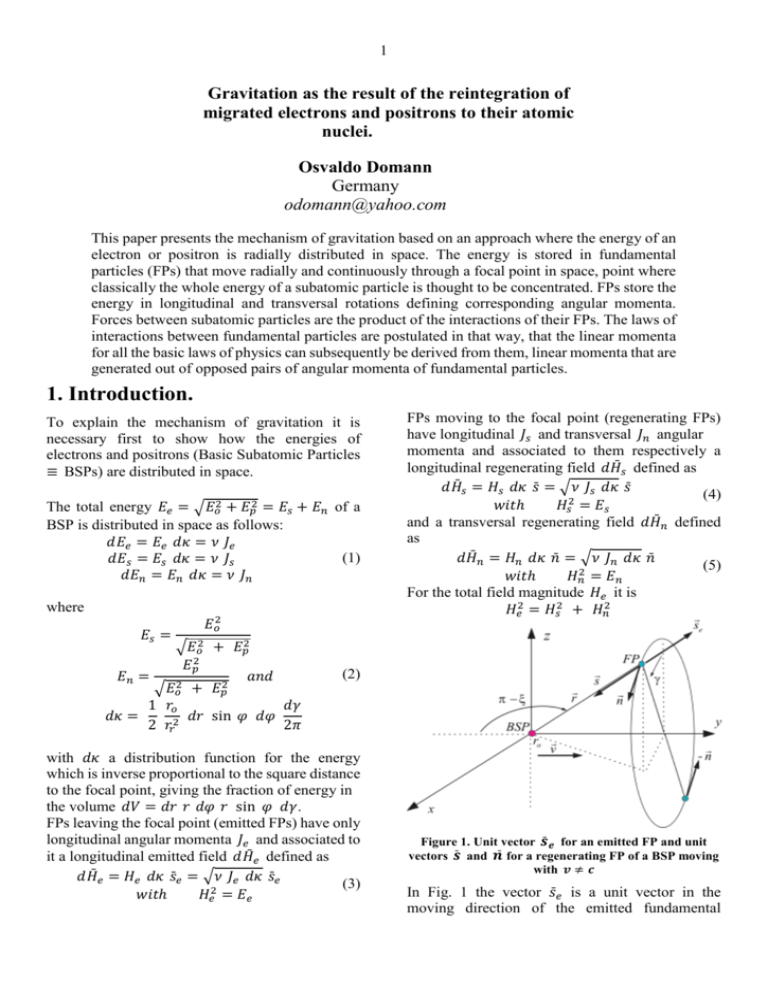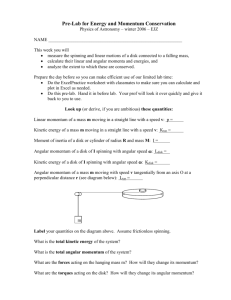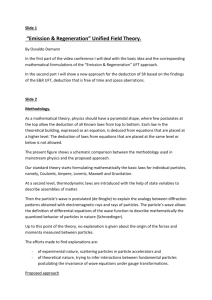(DOCX, Unknown)
advertisement

1 Gravitation as the result of the reintegration of migrated electrons and positrons to their atomic nuclei. Osvaldo Domann Germany odomann@yahoo.com This paper presents the mechanism of gravitation based on an approach where the energy of an electron or positron is radially distributed in space. The energy is stored in fundamental particles (FPs) that move radially and continuously through a focal point in space, point where classically the whole energy of a subatomic particle is thought to be concentrated. FPs store the energy in longitudinal and transversal rotations defining corresponding angular momenta. Forces between subatomic particles are the product of the interactions of their FPs. The laws of interactions between fundamental particles are postulated in that way, that the linear momenta for all the basic laws of physics can subsequently be derived from them, linear momenta that are generated out of opposed pairs of angular momenta of fundamental particles. 1. Introduction. To explain the mechanism of gravitation it is necessary first to show how the energies of electrons and positrons (Basic Subatomic Particles ≡ BSPs) are distributed in space. The total energy 𝐸𝑒 = √𝐸𝑜2 + 𝐸𝑝2 = 𝐸𝑠 + 𝐸𝑛 of a BSP is distributed in space as follows: 𝑑𝐸𝑒 = 𝐸𝑒 𝑑𝜅 = 𝜈 𝐽𝑒 (1) 𝑑𝐸𝑠 = 𝐸𝑠 𝑑𝜅 = 𝜈 𝐽𝑠 𝑑𝐸𝑛 = 𝐸𝑛 𝑑𝜅 = 𝜈 𝐽𝑛 where 𝐸𝑠 = 𝐸𝑜2 √𝐸𝑜2 + 𝐸𝑝2 𝐸𝑝2 𝐸𝑛 = 𝑎𝑛𝑑 √𝐸𝑜2 + 𝐸𝑝2 1 𝑟𝑜 𝑑𝛾 𝑑𝜅 = 2 𝑑𝑟 sin 𝜑 𝑑𝜑 2 𝑟𝑟 2𝜋 FPs moving to the focal point (regenerating FPs) have longitudinal 𝐽𝑠 and transversal 𝐽𝑛 angular momenta and associated to them respectively a longitudinal regenerating field 𝑑𝐻̄𝑠 defined as 𝑑𝐻̄𝑠 = 𝐻𝑠 𝑑𝜅 𝑠̄ = √𝜈 𝐽𝑠 𝑑𝜅 𝑠̄ (4) 𝑤𝑖𝑡ℎ 𝐻𝑠2 = 𝐸𝑠 and a transversal regenerating field 𝑑𝐻̄𝑛 defined as 𝑑𝐻̄𝑛 = 𝐻𝑛 𝑑𝜅 𝑛̄ = √𝜈 𝐽𝑛 𝑑𝜅 𝑛̄ (5) 𝑤𝑖𝑡ℎ 𝐻𝑛2 = 𝐸𝑛 For the total field magnitude 𝐻𝑒 it is 𝐻𝑒2 = 𝐻𝑠2 + 𝐻𝑛2 (2) with 𝑑𝜅 a distribution function for the energy which is inverse proportional to the square distance to the focal point, giving the fraction of energy in the volume 𝑑𝑉 = 𝑑𝑟 𝑟 𝑑𝜑 𝑟 sin 𝜑 𝑑𝛾. FPs leaving the focal point (emitted FPs) have only longitudinal angular momenta 𝐽𝑒 and associated to it a longitudinal emitted field 𝑑𝐻̄𝑒 defined as 𝑑𝐻̄𝑒 = 𝐻𝑒 𝑑𝜅 𝑠̄𝑒 = √𝜈 𝐽𝑒 𝑑𝜅 𝑠̄𝑒 (3) 𝑤𝑖𝑡ℎ 𝐻𝑒2 = 𝐸𝑒 Figure 1. Unit vector 𝒔̄ 𝒆 for an emitted FP and unit vectors 𝒔̄ and 𝒏̄ for a regenerating FP of a BSP moving with 𝒗 ≠ 𝒄 In Fig. 1 the vector 𝑠̄𝑒 is a unit vector in the moving direction of the emitted fundamental 2 particle (FP). The vector 𝑠̄ is a unit vector in the moving direction of the regenerating FP. The vector 𝑛̄ is a unit vector transversal to the moving direction of the regenerating FP and oriented according the right screw rule relative to the velocity 𝑣̄ of the BSP. which are constant for non relativistic speeds. Nucleons are composed of electrons and positrons which are concentrated in the range of 0 ≤ 𝛾 ≤ 0.1 of the curve of Fig. 3 where the attractions and repulsions between them are zero. Conclusion: Basic subatomic particles (BSPs) are structured particles with longitudinal and transversal angular momenta, with positive or negative emitted angular momenta (charge) and with a transversal field 𝑑𝐻̄𝑛 (mechanical momentum and magnetic moment). 2. Gravitation. The interaction law between FPs of static BSPs (Coulomb) follows the cross product between longitudinal angular momentum |𝐽̄𝑠1 × 𝐽̄𝑠2 | = 𝐽𝑠1 𝐽𝑠2 sin 𝛽 of the FPs, which is zero for the distance 𝑑 = 0 between BSPs because of 𝛽 = 𝜋. The differential linear momentum 𝑑𝑝 on a BSP is generated out of pairs of opposed angular momenta 𝐽̄𝑛 at the regenerating FPs of the BSP. At a moving BSP, opposed pairs of angular momenta are generated at the regenerating FPs because of the axial symmetry of the FPs relative to the velocity of the BSP as shown in Fig. 1. In Fig. 2 the differential linear momentum 𝑑𝑝2 at BSP 2 is generated by pairs of opposed angular momenta 𝐽̄𝑛2 of regenerating FPs. Figure 3. Linear momentum d / ro 𝒑𝒔𝒕𝒂𝒕 as function of between two static BSPs with equal focal radii 𝒓𝒐𝟏 = 𝒓𝒐𝟐 Electrons and positrons of a stable nucleon migrate slowly into the range of 0.1 ≤ 𝛾 ≤ 1.8 polarizing the nucleon, and are subsequently reintegrated with high speed when their FPs cross with FPs of the remaining electrons and positrons of the nucleon, because of 𝛽 < 𝜋 as shown in Fig. 4 for Neutron 1. Figure 2. Generation of angular momenta 𝑱𝒏 at regenerating fundamental particles of two static basic subatomic particles at the distance 𝒅 Fig. 3 shows the linear momentum between two BSPs as a function of the distance 𝑑. The variable 𝑟𝑜 represents the radii of the focus of the BSPs, Figure 4. Transmission of momentum 𝟏 to neutron 𝟐 𝒅𝒑 from neutron 3 The opposed transversal angular momenta 𝐽̄𝑛 responsible for the dH n fields at the FPs of each reintegrating electron or positron of a nucleon, are captured by regenerating FPs of an electron or positron of another nucleon, generating the attracting force between the nucleons as shown in Fig. 4. Reintegrating BSP ’b’ of neutron 1 hands over its opposed angular momenta to BSP ’p’ of neutron 2 with the result, that the linear momentum 𝑑𝑝𝑏 of BSP ’b’ reduces to zero while the linear momentum 𝑑𝑝𝑝 of BSP ’p’ increases by the same magnitude complying with the conservation law for momentum. To calculate the gravitation force induced by the reintegration of migrated BSPs, we need to know the number of migrated BSPs in the time Δ𝑡 for a neutral body with mass 𝑀. The following equation was derived in [6] for the induced gravitation force generated by one reintegrated electron or positron 𝐹𝑖 = √ℎ 𝜈𝑛 √𝑚𝑝 𝑑𝑝 = ∫ ∫ 𝛥𝑡 4 𝐾 𝑑 2 𝐺𝑟𝑎𝑣 𝑤𝑖𝑡ℎ ∫∫ (6) Δ𝐺1 Δ𝐺2 = 𝐺 4 𝐾 𝑀1 𝑀2 √ℎ 𝜈𝑛 √𝑚𝑝 ∫ ∫𝐺𝑟𝑎𝑣 (10) Because of energy exchange quantization derived in [6] which states that energy is quantized in energy quanta of a resting electron 𝐸𝑜 = ℎ 𝜈𝑜 with 𝜈𝑜 = 1.2373 ⋅ 1020 𝑠 −1 , we replace ℎ 𝜈𝑛 by ℎ 𝜈𝑜 in eq. (6) and get Δ𝐺1 Δ𝐺2 = 2.1493 ⋅ 1016 𝑀1 𝑀2 (11) Δ𝐺1 Δ𝐺2 = 𝛾𝐺2 𝑀1 𝑀2 and Δ𝐺 = 𝛾𝐺 𝑀 𝑤𝑖𝑡ℎ (12) 𝛾𝐺 = 1.4661 ⋅ 108 𝑘𝑔−1 Calculation example: The number of migrated BSPs that are reintegrated at the sun and the earth in the time Δ𝑡 are respectively, with 𝑀⊙ = 1.9891 ⋅ 1030 𝑘𝑔 and 𝑀† = 5.9736 ⋅ 1024 𝑘𝑔 Δ𝐺⊙ = 2.9162 ⋅ 1038 𝑎𝑛𝑑 (13) 32 Δ† = 8.7579 ⋅ 10 The power exchanged between two masses due to gravitation is 𝑃𝐺 = 𝐹𝐺 𝑐 = 2.4662 𝐺𝑟𝑎𝑣 where 𝑚𝑝 is the mass of the electron and ℎ the Planck constant and Δ𝑡 = 𝐾 𝑟𝑜2 𝑟𝑜 = 3.8590 ⋅ 10−13 𝑚 (7) 𝐾 = 5.4274 ⋅ 104 𝑠/𝑚2 The direction of the force 𝐹𝑖 on the capturing BSP is independent of the sign of the reintegrating BSP and is always oriented to the reintegrating BSP. For two bodies with masses 𝑀1 and 𝑀2 and where the number of reintegrated BSPs in the time Δ𝑡 is respectively Δ𝐺1 and Δ𝐺2 it must be 𝑀1 𝑀2 𝐹𝐺 = 𝐹𝑖 Δ𝐺1 Δ𝐺2 = 𝐺 (8) 𝑑 2 −11 𝐺 = 6.6726 ⋅ 10 As the direction of the force 𝐹𝑖 is the same for reintegrating electrons Δ−𝐺 and positrons Δ+𝐺 it is (9) Δ𝐺 = |Δ−𝐺 | + |Δ+𝐺 | and we get that 𝑃𝐺 = 𝑐 √ℎ 𝜈𝑜 √𝑚𝑝 4 𝐾 𝑑 2 Δ𝐺1 Δ𝐺2 ∫ ∫ (14) 𝐺𝑟𝑎𝑣 The power exchanged between the sun and the earth is, with 𝑑⊙† = 1.49476 ⋅ 1011 𝑚 𝑀⊙ 𝑀† 𝑃𝐺 = 𝐹𝐺 𝑐 = 𝐺 2 𝑐 𝑑⊙† (15) 𝑃𝐺 = 7.8156 ⋅ 1019 𝐽/𝑠 3. Dark matter. In the previous sections we have seen that the origin of the gravitation force is the induced force due to the reintegration of migrated BSPs in the direction of the two gravitating bodies. When a BSP is reintegrated to a neutron, the two BSPs of different signs that interact produce an equivalent current in the direction of the positive BSP as shown in Fig. 5. 4 𝑝𝑏 𝐾𝐷𝑎𝑟𝑘 = 𝑤𝑖𝑡ℎ 𝛥𝑜 𝑡 𝑑 1 ℎ 𝐾𝐷𝑎𝑟𝑘 = 2 𝛥𝑜 𝑡 = 4.09924 ⋅ 10−14 𝑁𝑚 𝑑𝐹𝑅 = 𝐾𝐷𝑎𝑟𝑘 (20) The total force is 𝐹𝑅 = Figure 5. Resulting current due to reintegration of migrated BSPs As the numbers of positive and negative BSPs that migrate in one direction at one neutron are equal, no average current should exists in that direction in the time Δ𝑡. It is (16) Δ𝑅 = Δ+𝑅 + Δ−𝑅 = 0 We now assume, that because of the power exchange between the two neutrons (15), a synchronization exists between the reintegration of BSPs of equal sign in the direction orthogonal to the distance between the two neutrons, resulting in parallel currents of equal signs that generate an attracting force between the neutrons. Thus the total attracting force between the two neutrons is produced first by the induced force FG and second by the parallel currents FR of reintegrating BSPs. FT = FG + FR with M1 M2 FG = G (17) d2 M1 M2 FR = R d 𝐾𝐷𝑎𝑟𝑘 𝑀1 𝑀2 Δ𝑅1 Δ𝑅2 = 𝑅 𝑑 𝑑 (21) We get Δ𝑅1 Δ𝑅2 = 𝑅 𝐾𝐷𝑎𝑟𝑘 𝑀1 𝑀2 (22) or Δ𝑅1 Δ𝑅2 = 𝛾𝑅2 𝑀1 𝑀2 𝑅 𝛾𝑅2 = 𝐾𝐷𝑎𝑟𝑘 𝑤𝑖𝑡ℎ (23) and Δ𝑅 = 𝛾𝑅 𝑀 (24) The total attracting force gives 𝐹𝑇 = 𝐹𝐺 + 𝐹𝑅 = [ 𝐺 𝑅 + ] 𝑀1 𝑀2 𝑑2 𝑑 (25) For sub-galactic distances the induced force 𝐹𝐺 is predominant, while for galactic distances the force of parallel reintegrating BSPs 𝐹𝑅 predominates, as shown in Fig. 6. To obtain an equation for the force 𝐹𝑅 we start with an equation that was deduced in [6] for the linear momentum when electrons are bent through a crystal, equation that is based on the interaction of parallel currents. 1 5.8731 ℎ 𝜈𝑜 (18) 𝑝𝑏 = Δ𝑙 𝑛 4 64 𝑐 𝑑 with 𝜈𝑜 = 1.2373 ⋅ 10 20 𝑠 −1 Δ𝑙 = 5.2843 ⋅ 10−11 𝑚 Δ𝑜 𝑡 = 8.0821 ⋅ 10−21 𝑠 (19) The force for one pair of parallel BSPs (𝑛 = 1) is given by Figure 6. Gravitation forces at sub-galactic and galactic distances. Calculation example: For the sun with 𝑣𝑜𝑟𝑏 = 220 𝑘𝑚/𝑠 and 𝑀2 = 𝑀⊙ = 2 ⋅ 1030 𝑘𝑔 and a distance to the core of the Milky Way of 𝑑 = 25 ⋅ 1019 𝑚 we get a centrifugal force of 5 2 𝑣𝑜𝑟𝑏 𝐹𝑐 = 𝑀2 = 3.872 ⋅ 1020 𝑁 𝑑 (26) With the mass of the core of the Milky Way of 𝑀1 = 4 ⋅ 106 𝑀⊙ and 𝑀1 𝑀2 𝐹𝑐 = 𝐹𝑇 ≈ 𝐹𝑅 = 𝑅 𝑑 𝑅 = 6.05 ⋅ 10−27 𝑁𝑚/𝑘𝑔2 (27) and with 𝐹𝐺 = 𝐹𝑅 we get (28) 𝑑𝑔𝑎𝑙 = 𝐺 = 1.103 ⋅ 1016 𝑚 𝑅 justifying our assumption that 𝐹𝑇 ≈ 𝐹𝑅 because the distance between the sun and the core of the Milky Way is 𝑑 ≫ 𝑑𝑔𝑎𝑙 . We also have that 𝑅 𝛾𝑅 = √ = 3.842 ⋅ 10−7 𝑘𝑔−1 𝐾𝐷𝑎𝑟𝑘 (29) If we compare with 𝛾𝐺 = 1.4661 ⋅ 108 𝑘𝑔−1 for the induced force we see that 𝛾𝑅 is very small. Note: The flattening of galaxies´ rotation curve was derived based on the assumption that the gravitation force is composed of an induced component and a component due to parallel currents of reintegrating BSPs and, that for galactic distances the induced component can be neglected. Note: We also may assume that the synchronization of the reintegrating BSPs in the orthogonal direction of the two neutrons results in parallel currents of opposed signs, generating a repulsive force between the two neutrons. 4. Summary of main characteristics of the proposed model. The main characteristics of the proposed model, with gravitation a part of it, are: The approach is Lorentz invariant, quantification and probability are inherent to it. The energy of a BSP is stored in the longitudinal angular momenta of emitted fundamental particles. The rotation sense of the longitudinal angular momentum defines the charge of the BSP. All the basic laws of physics (Coulomb, Ampere, Lorentz, Maxwell, Gravitation, bending of particles and interference of photons, Bragg, Laue, Schroedinger, Stern-Gerlach) are mathematically derived from the proposed model, proving that the approach is in accordance with experimental data. All known forces are derived as rotors from one vector field generated by the longitudinal and transversal angular momenta of fundamental particles. The coexistence of BSPs of equal charge in the atomic nucleus does not require the definition of a special strong force nor additional mediating particles (gluons). The emission of particles from heavy atomic nucleus does not require the definition of a special weak force nor additional mediating particles. Gravitation has its origin in the reintegration of migrated BSPs to nuclei of bodies. No special mediating particles are required (gravitons). The gravitation force is composed of an induced component and a component due to parallel currents of reintegrating BSPs. For galactic distances the induced component can be neglected, what explains the flattening of galaxies´ rotation curve (no dark matter is required). The interacting particles for all types of interactions (electromagnetic, strong, weak, gravitation) are the FPs with their longitudinal and transversal angular momenta. The wave character of the photon is defined as a sequence of BSPs with potential opposed transversal linear momenta, which are generated by transversal angular momenta of FPs that comply with specific symmetry conditions. Light that moves through a gravitation field can only lose energy, what explains the red shift of light from far galaxies (no expansion of the universe is required). The addition of a wave to a particle (de Broglie) is effectively replaced by a relation between the particles focal radius and its energy. Deflection of particles such as the electron is now a result of the quantified bending linear momentum between BSPs due to the quantification of energy exchange. Quantum mechanics constructed with the focal radius instead of the de Broglie wave-length 6 gives a differential equation where the wave function is differentiated two times towards time and one towards space. The uncertainty relations form pairs of canonical conjugated variables between "energy and space" and "momentum and time”. The Schrödinger equation results as a particular time independent case of the wave packet. The new quantum mechanics theory, based on wave functions derived with the focal radius, is in accordance with the quantum mechanics theory based on the correspondence principle. As the model relies on BSPs permitting the transmission of linear momentum at infinite speed via FPs, it is possible to explain that entangled photons show no time delay when they change their state. The two possible states of the electron spin are replaced by the two types of electrons defined by the present theory, namely the accelerating and decelerating electrons. The magnetic spin moment 𝜇𝑠 that is responsible for the splitting of the atomic beam in the Stern-Gerlach experiment is replaced by the quantized bending moment of parallel currents of electrons. 5. References. 1. Albrecht Lindner. Grundkurs Theoretische Physik. Teubner Verlag, Stuttgart 1994. 2. Benenson ⋅ Harris ⋅ Stocker ⋅ Lutz. Handbook of Physics. Springer Verlag 2001. 3. Stephen G. Lipson. Optik. Springer Verlag 1997. 4. B.R. Martin & G. Shaw. Particle Physics. John Wiley & Sons 2003. 5. Max Schubert / Gerhard Weber. Quantentheorie, Grundlagen und Anwendungen. Spektrum, Akad. Verlag 1993. 6. O. Domann. Definition of a space with fundamental particles with longitudinal and transversal rotational momentum, and deduction of the linear momentum which generates electrostatic, magnetic, induction and gravitational forces. June 2003. http://www.odomann.com/







